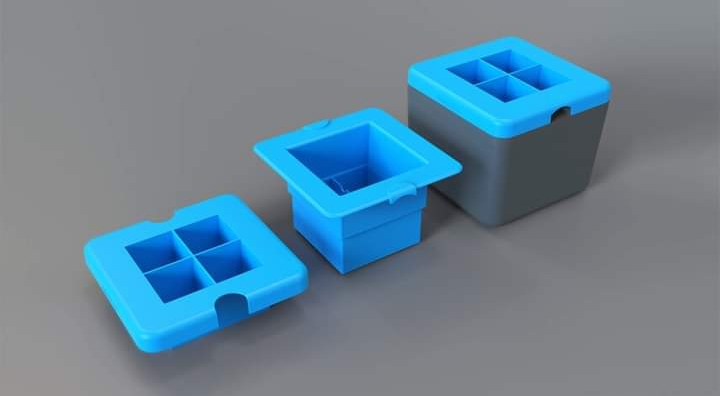
From Spoilage to Savings: How an Electric Fridge Can Transform Millions of Lives
Many people in the world still do not have access to electricity. In most cases, electricity service is precarious for those who can use it in small quantities. Because of this, many people cannot use the refrigerator.
Light and easily portable coolers can help these people who do not have access to sufficient electricity. Billions of people will be able to keep their food fresh using this device.
US company Evaptainers (EVaptainers) technology company’s EV-8 (EV-8) cooler can cool the temperature using the evaporation method. In this, the temperature inside the cooler is 15 to 20 degrees Celsius lower than the outside temperature.
EV-8 is not only useful if there is no refrigerator at home. This technology can help many people in refugee camps, besides it is useful in natural disasters.
“The cooler can keep food fresh for double or triple the time,” says Quang Trung. The idea of this technology is basically his. He co-founded a Boston-based company called Evaptainers with Spencer Taylor.
Evaptainers tested several prototypes of the device in Morocco. Tomatoes are good for 2 to 3 days when opened. But a tomato will stay fresh for a week if kept in this device. And where onions are good for 5 days, using this device can be kept fresh for 10 days to two weeks.
Morocco, a country with a hot and dry climate, is the perfect place to test the device, as the cooler’s performance is best understood in such an environment.
People from the world’s most backward communities live in such an environment. India, the Congolese forest region of northern and southern African countries, the entire continent of Australia, and the southwestern states of America have average humidity below 65 percent. As a rule, the drier the air, the higher the rate of evaporation.
Taylor and Truong expect their technology to benefit about 652 million people.

How is it so cold inside the cooler?
If one gets out of the pool during hot summer, he will understand the cooling effect of evaporation. The science of it is quite simple. We know heat makes molecules vibrate. Heating a liquid causes the molecules inside it to become gas molecules, causing them to diffuse from the surface of the liquid into the air. Molecules take some heat with them as they go. The molecules that remain are then cooled.
The technique of cooling something by evaporation has been around for hundreds of years. An Egyptian painting from 2,500 years ago shows slaves fanning a stone vessel, cooling its contents. Leonardo da Vinci experimented with the evaporation technique, as did Benjamin Franklin. But then electricity came to earth. At the same time, the method of evaporative cooling, which had been introduced, fell out of favor.
In the late 1990s, a Nigerian named Mohammed Bah Abba started recycling the old technique of ‘pot within pot’ made of clay.
This method is still used. It consists of two earthen vessels, one smaller than the other. The smaller pot is placed inside the larger one, and the space between the two pots is filled with sand.
Containers have a mold with fine perforations to allow the movement of liquids. The mold must first be soaked in water. Then placing a cool wet cloth on top as a cover allows evaporation. This keeps the perishables inside the container fresh for longer.
Although this is a great innovation, the method has not caught on well outside Nigeria. Because clay pots have a lifespan of roughly one to two years. Once they break, or the pores become blocked, they no longer work. To avoid this, many pots will be made and kept together, which is also a troublesome task. Again, if too much or too little water is given in the pot, it does not work well.
One day it occurred to Truong that these vessels could be improved. He was taking a class on budding entrepreneurs at the Massachusetts Institute of Technology. He was tasked with coming up with a service that would change the lives of a billion people.
He began traveling to countries like Vietnam, Haiti, India and Liberia. He reflects on how he is often disturbed by the smell of rotting food while traveling in these countries. After some research, he found that, according to data from the Food and Agriculture Organization of the United Nations, about 45 percent of Africa’s fruits and vegetables perish before reaching the market. Truong then thought he could transform the “pot within a pot” concept into something larger and more modernly light.
It is about 2012. It was during this time that Truong and Taylor developed several prototypes of the technology. They also won several innovation competitions. Then they thought, the product can be brought to the market now.
They expected the market value of the EV-8 cooler to be between $30 and $35.
Introduction to EV-8
The EV-8 has a collapsible top and bottom made of rigid, lightweight membrane. Evaptainers made it, the membrane they called PhaseTek. Due to the tough coating, they can easily withstand the shock of shipping. To open the box, press lightly on the fiberglass at each corner.
It is 21 inches long, 16 inches wide and 11 inches high. This volume holds 60 liters of water.
Users have to put 1 liter of water in the container for cooling. So that its four membranes get wet. Then gradually the water evaporates and the inside starts to cool. The user only needs to fill this water container once a day. From here water reaches the container as needed. And 1 liter of water evaporates every six to eight hours.
In 2017, the EV-8 won the People’s Choice Award in San Francisco. This is their latest award. The company recently launched its final pilot program in Morocco before bringing the EV-8 to full commercial production.
“Everyone on our team is enthusiastic about this project. Everyone has confidence in the current version, it will benefit a lot of people,” Truong said.
Fridge, electricity, technology, Electric fridge, refrigeration, food security, food waste, developing countries, sustainable development, poverty alleviation, health, nutrition, livelihoods, economic empowerment,





